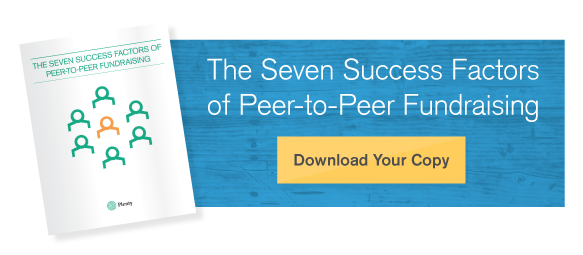Master Fundraising Segmentation: Part 1
A friend of mine reached out over the weekend with a common question asked amongst fundraisers and marketers looking to improve their results – which, let’s be honest, is every fundraiser and marketer on earth.
Hey Jeff! I had two quick questions for you. Do you have any strategies for segmenting contacts based on data you haven't yet collected from the user? Or how to go about getting users to volunteer that information?
She went on to explain that her nonprofit, which focuses on improving the health and wellness of newborn babies and their mothers, is starting a new campaign to target expectant mothers. They want to engage with those moms via influencers on Facebook. They are also considering an outbound campaign to their existing list. And, they are specifically interested in targeting the Latino community.
The problem is that their existing list doesn’t have all the fields they need. In particular, they do not collect ethnicity information.
The quick answer is, I have a lot of ideas on how to crack this nut, but first, let’s take a step back and consider why we want to segment in the first place.
There Are Two Kinds of PeopleWe’ve all learned that there are two kinds of people, right? There are people who like the Indianapolis Colts and there are people with no taste in football. Wait, no, that isn’t right. There are the good people and the bad people. Is that it? There are people on Facebook and there are three people who aren’t. Or is it, there are people who segment and people who don’t?
The point is, there aren’t two kinds of people. There are, literally, billions of kinds of people. Everyone is unique. In our personal lives, we yearn to be seen as the individuals we are. We bristle when others try to group us into buckets. Comments like “You are just like your sister” or “All people from Indiana are hicks” rub us the wrong way, just as reading a letter addressed to “Dear Sir or Madam” seems vaguely insulting. Taken further, generalizations aimed towards us can seem demeaning, stereotypical, biased, and even bigoted.
When we work with our clients on segmentation, part of the work involves trying to find groups of constituents who are similar enough that we could customize messages to them. And it can be fun to work our preschool sorting muscles, putting round pegs into round holes, red blocks with other red blocks.
But we always caution our clients not to get carried away. We have to remember the reason we’re sorting people in the first place. The idea isn’t to stereotype or generalize them. Rather, the idea is the opposite: We’re trying to make our communications as personal as possible. If we could, we’d make every communication specially crafted for each and every donor. Since that isn’t possible, we use segmentation to get as close as we can.
It is critical to remember that the goal of segmentation is personalization, not generalization. Keeping this in mind will help you create more effective segments; keep you focused on tailoring communication; and most importantly, keep you in a constituent-focused frame of mind.
Three Strategies to Get InformationNow that we have ourselves in the right headspace about why we segment, where do we start? At Plenty, we use a blend of right-brain and left-brain thinking to create effective segments. The right brain involves interviews and qualitative exploration to see if we can identify traits and behaviors in our constituents. The left brain involves using data mining and machine learning techniques like association rules and clustering to see what kinds of patterns emerge.
Both processes require information, and this brings us all the way back to the original question from my friend.
There are three basic ways to get information from your constituent base:
-
Buy it.
-
Ask them for it.
-
Observe them to create it.
Buy It. The easiest way is to just buy it. Take your list of constituents, send it to a service like Axciom, and your original data will come back appended with the fields you want. Depending on the field you are looking for, the match rate – the number of records for which the data you are seeking is available – might be quite high or really low. The match rate for something like education level might be 95% or higher, meaning you can find the information for 95% of your database. The match rate for something more specific, like “number of diabetic children in the home,” might be really low.
Buying data can be really effective, although there are some limitations.
-
First, it costs money – although not as much as you might think. But on an ongoing basis, those small purchases start to add up quickly.
-
Second, buying data is great for one-time analysis, like the kind you might do before launching a campaign. But it isn’t so slick for ongoing use. Doing a monthly data append can get cumbersome quickly.
-
Finally, many people find it slightly distasteful to investigate constituents “behind their backs.” I’m of a couple of minds about this. On the one hand, we live in an age where everything – literally everything – we do is tracked. So I think we’ve crossed this watershed, like it or not. Still, I’d rather be upfront with constituents.
Which brings us to…
Ask Them For It. Very often you will find you can ask constituents for information if you give them good context for why you need it and what you are going to do with it. The key here is to realize this is a value exchange. You are asking for something important (their information). In return you usually need to show that you deserve it for more reasons than “because you are a nonprofit” or “because you need it.”
To the specific scenario my friend asked about, their might be a way to ask about ethnicity on a basic form by talking about why you are looking to capture it: “Did you know that there are inequalities in nutrition related to ethnicity? We are trying to collect data on our mothers so we can create a safe future for all of the world’s children.” In some contexts you’d find that works really well.
There are several obvious benefits to asking. First, you’re being upfront – always good. Second, it can be surprisingly effective. Third, the process of thinking through how you are going to ask can often help clarify for you why you think you need the data in the first place. If you can’t explain why, perhaps you don’t need it.
The only drawback to asking is that it doesn’t help with all of the existing records you have. Getting information for the 30 people who filled out your form today doesn’t help much if you have a database of 30,000 donors. In those cases, you often need to start by buying, then put an ongoing ask in place.
Observe Them. Often an important way to get data is by just watching what people do in the digital space. For example, there are software solutions like Hubspot and Google Analytics which allow you to see where people go on your website. You can get an amazing amount of information from these tools. Imagine seeing a group of people visiting the childcare portion of your website at 2:00 in the morning and another group visiting the wellness portion of your website at 10:00 a.m. That might tell us something about their current needs, and we might want to test a segment around those behaviors. Marketing is a conversation between your audience and your organization. Make sure you spend as much time observing and listening as you spend talking.
What’s Next?Okay, so you have information on your constituents. What’s next? Well, what’s next is we use that information to develop a few segments, and then we test those segments by sending more customized messages to each than we are sending to the entire database.
I have to admit, there’s more to it than just that – but we’ll have to save that for Part 2 (coming soon!)
Stay tuned for Part 2 on how to become a fundraising segmentation master! Until then, brush up on your fundraising skills with our "Seven Success Factors" e-book, which is designed to walk you through the seven most important areas impacting your program's growth.
Share this
You May Also Like
These Related Stories
After The Ice Buckets: How To Date Dave




No Comments Yet
Let us know what you think